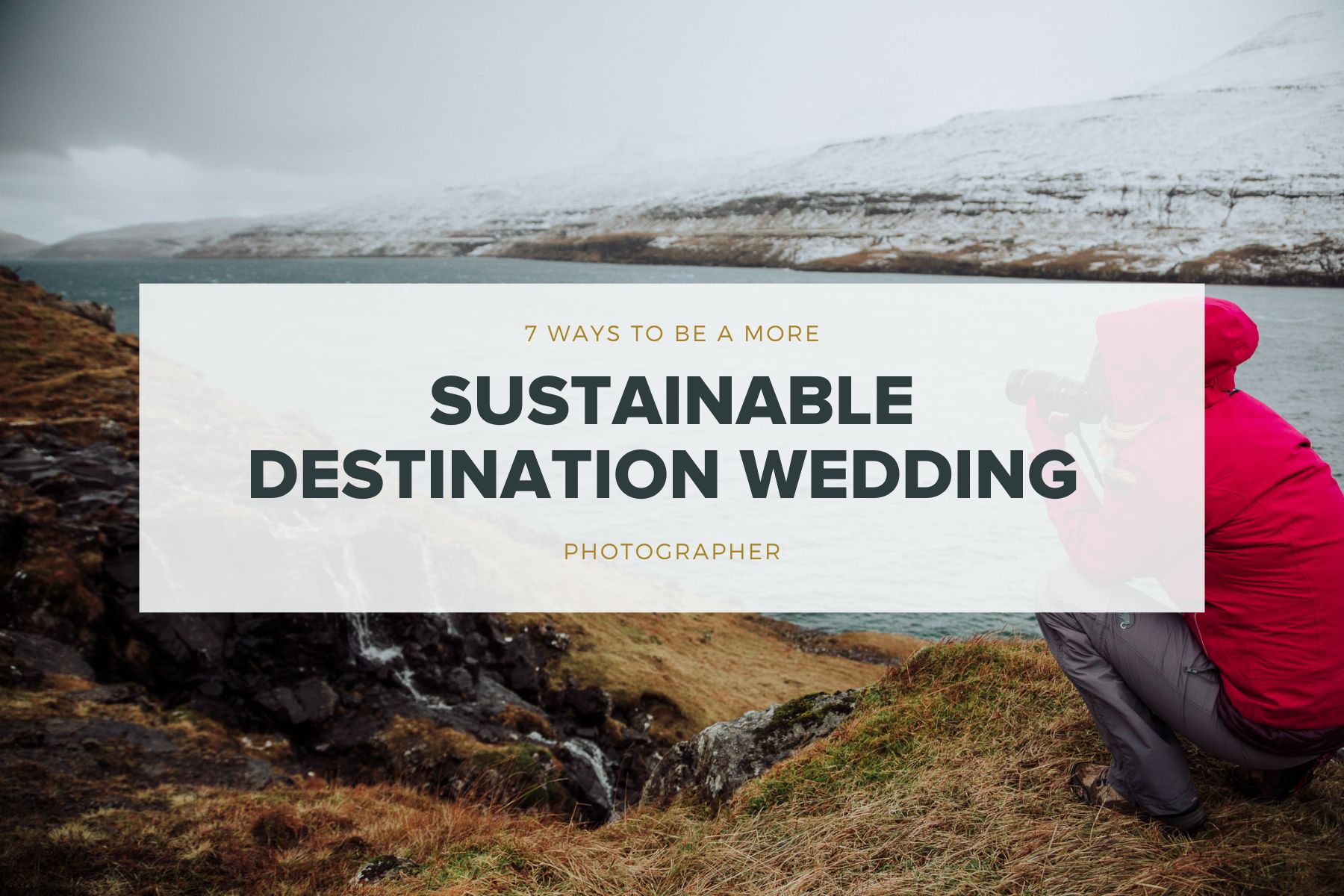7 Ways To Be A More Sustainable Destination Wedding Photographer
Sustainability has become a bit of a buzzword these days. It’s great that more people are talking about trying to be more sustainable, but what does that actually mean? And how can we make sure that when we are trying to be more sustainable, we’re not just “greenwashing” and taking performative actions, but actually making lasting and sustainable changes?
As a destination photographer, there are a unique set of challenges when it comes to sustainability. Travel is an essential part of your business, but it’s also an area that can have the most significant impact on the environment. However, there are steps you can take to minimize your carbon footprint and create a more sustainable photography business, whilst still doing the job you love.
In this article, we’ll explore seven practical and effective ways to operate more sustainably as a destination wedding photographer. From reducing travel to using sustainable suppliers, these tips can help you run a more eco-friendly and socially responsible photography business, without sacrificing your creative vision or your bottom line.
Practice “Leave No Trace”
Learning about Leave No Trace is crucial for photographers who want to practice sustainability in their work. This means being mindful of our impact when shooting outdoors and taking steps to preserve the environment.
Photographers who are familiar with Leave No Trace principles can avoid causing damage to fragile ecosystems, preserving the beauty of the natural world they capture in their images. By following the principles of Leave No Trace, photographers can also help educate others on the importance of sustainability and environmental stewardship.
Furthermore, sustainability is becoming increasingly important in the photography industry. Clients are looking for photographers who share their values and are committed to sustainable practices. By incorporating Leave No Trace principles into their work, photographers can demonstrate their commitment to sustainability and attract clients who prioritize environmental responsibility.

Support Diversity & Inclusion
Supporting diversity and inclusion in your portfolio is incredibly important as a photographer, and not just because it’s the right thing to do. When you showcase diversity in your portfolio, you’re demonstrating that you’re an inclusive photographer who values all people and perspectives. You’re also showing potential clients that you’re capable of capturing images that reflect a broad range of experiences, cultures, and backgrounds.
But here’s the thing, it’s not enough to just throw a few diverse models into your portfolio to show that you’re inclusive. That’s tokenism, and it’s not authentic or respectful. Instead, you need to approach diversity and inclusion with integrity. This means taking the time to educate yourself about different cultures and experiences, and seeking out models and subjects who authentically represent the diversity you want to showcase.
Here are a few ways to do this with integrity:
- Pay models for styled shoots: If you’re doing a styled shoot, consider paying the models you hire. This ensures that you’re not just using people’s identities and cultures for your own benefit, but also supporting their work and contributions.
- Reach out to diverse communities: Don’t just rely on your current network or social media following. Take the time to reach out to diverse communities and seek out individuals who authentically represent the diversity you want to showcase in your portfolio.
- Collaborate with diverse creatives: Seek out other photographers, models, stylists, and makeup artists who share your commitment to diversity and inclusion. Collaborating with diverse creatives can help you create images that are authentic and respectful.
In addition to showcasing diversity in your portfolio, using inclusive language and hiring staff from diverse backgrounds are also important steps towards achieving diversity, equity, and inclusion (DEI) in your business.
Using inclusive language means being mindful of the words you use and the messages they convey. For example, instead of using gendered language, you can use gender-neutral terms like “partner” instead of “husband” or “wife”. This not only shows respect for all gender identities, but also demonstrates your commitment to creating an inclusive environment.
It’s important to remember that supporting diversity and inclusion in your business isn’t just about optics. It’s about equity and social justice. By intentionally including diverse models and subjects in your portfolio, using inclusive language and working with diverse teams, you’re helping to create a more equitable and inclusive industry. So let’s get out there and showcase the beauty of diversity!

Price For Profit
Discounting and undercutting the market when shooting destination weddings can have a detrimental impact on local communities and local vendors. Here’s why:
When you offer steep discounts or undercut the local market, you can inadvertently devalue the work of local vendors, including planners, florists, and caterers. This can create an unfair and unsustainable dynamic where local vendors are forced to lower their prices in order to compete with out-of-town photographers who are offering their services at below-market rates. This can be particularly problematic in areas where tourism and destination weddings are not only significant sources of revenue for local economies, but where living costs can be high. This can ultimately harm the local vendors and their communities, as they may not be able to sustain their businesses or offer fair wages to their employees. Additionally, if you consistently offer discounts or undercut the market (whether that’s where you live or for destination work), you risk devaluing your own work and the work of other photographers. This can create a race to the bottom, where you are forced to offer lower and lower prices to compete, not only harming your own business, but ultimately harming the industry as a whole.
On the flipside, pricing your photography for profit allows you to reinvest in your business, which is crucial for long-term sustainability. This includes investing in equipment, marketing, and continuing education, all of which can help you improve your skills and offer even better services to your clients.
Pricing your photography for profit also ensures that you’re able to provide a sustainable income for yourself and anyone you might employ/outsource to. By valuing your own work and setting fair prices, you’re able to build a successful and sustainable business that can provide for you and even a support team in the longer-term. You might even be able to make some charitable donations on behalf of your business, if that’s something you would like to do.
Of course, pricing your photography for profit doesn’t mean you should overcharge your clients or price yourself out of the market. It simply means setting prices that reflect the value of your work and the cost of running your business. By doing so, you can create a sustainable business that not only benefits you but also helps to support the photography industry as a whole. It can also help you to build a reputation as a responsible and socially conscious professional, which can ultimately benefit your businesses in the long run!
Reduce Travel
Reducing travel is an important step towards achieving sustainability, but for photographers who specialize in destination weddings and elopements, this can be a challenging task.
Here are a few ideas on how to reduce travel as a destination wedding photographer:
- Plan ahead: Whenever possible, plan your travel and shoot schedule in advance to minimize the number of trips you need to take. This may mean coordinating with your clients and vendors to schedule multiple shoots in the same location, or planning your travel routes to include several locations in one trip.
- Work with local vendors: Partnering with local vendors, such as florists, planners, and makeup artists, can help you reduce travel and minimize your carbon footprint. By working with local vendors, you can reduce the need to travel with your own team or equipment, which can also save you time and money.
- Use sustainable transportation: When you do need to travel, try to use sustainable transportation options wherever possible, such as public transportation, carpooling with other vendors, or consider renting a hybrid or electric vehicle if you need a car.
- Shoot closer to home: While it may not be feasible to completely eliminate travel from your business, you can still make a difference by choosing to shoot closer to home whenever possible. This may mean focusing on local weddings and events, or branching out into new markets that are closer to your home base.
Ultimately, reducing travel as a destination wedding photographer may require some creative thinking and strategic planning, but by taking steps to minimize your carbon footprint, you can help protect the planet and create a more sustainable photography business.
Remove Physical Products
Photographers love printed products like albums and prints because they provide a tangible, lasting memory of a special moment in time. They can be held, touched, and displayed, and add a personal touch to a space. However, the production, packaging, and shipping of these products can have a significant environmental impact.
For this reason, it is important to consider more sustainable options, such as offering digital-only delivery, or by using eco-friendly materials and working with local vendors. By doing so, photographers can continue to provide their clients with beautiful, high-quality products while also promoting a more sustainable and socially responsible photography industry.
Removing physical products and only delivering digital images can be a more sustainable choice for several reasons:
- Reduced carbon footprint: By eliminating the need to ship physical products, such as prints and albums, photographers can significantly reduce their carbon footprint. This can be particularly important for destination photographers, who may need to ship products internationally or across long distances.
- Lower costs: By eliminating physical products, photographers can also lower their costs. This can increase profit which they can invest in other areas of their business, or can allow them to offer more competitive pricing to their clients.
- More flexible delivery options: Delivering digital images allows photographers to offer more flexible delivery options to their clients. Instead of waiting for physical products to be shipped, clients can receive their images quickly and easily via email, online galleries, or other digital delivery methods.
- Less waste: Eliminating physical products also means less waste. This can be particularly important for photographers who may have a limited storage space or who want to minimize their environmental impact.
If you do want to offer physical printed products such as albums and prints, there are several steps they can take to do so in a more sustainable manner:
- Work with sustainable suppliers: Choosing to work with suppliers who prioritize sustainability and ethical practices can help reduce the carbon footprint products. This could include suppliers who use recycled materials and environmentally friendly production processes in their production, as well as in their packaging. Look for materials that are made from recycled or sustainable sources, such as FSC-certified paper or recycled metal.
- Pick local suppliers: There are some great print labs across the world, but if you have the option, choose a lab that is in the same region that your clients are in. This reduces the distances the products need to be shipped.
- Ship direct to clients: Consider having products shipped directly to clients. Not only does this reduce the distance the products are traveling, but it also reduces the amount of packaging materials needed.
- Don’t order samples: If you work with destination clients, it’s unlikely that you are going to be able to show them samples of printed products, such as albums or fine art prints in person. Sample products often end up being photographed a few times, and used for a season or two, then often discarded.

Work Legally
As a destination photographer, working legally is not just about avoiding run-ins with the law, but also about being a responsible and sustainable business owner. By obtaining the necessary permits or visas, whether that’s in a foreign country or at home in a national park, you show respect for regulations and the local economy.
Working legally generally involves obtaining any necessary permits, visas, or licenses required to work in the destination country or region. This may include obtaining a work visa or temporary resident permit, as well as any necessary permits to shoot in public spaces or landmarks. It is important to research the legal requirements for each destination and ensure you are in compliance before booking a wedding.
So, before you jet off to your next destination wedding, make sure you’ve done your research and are in compliance with all necessary legal requirements. It’s not only good for your peace of mind, but also for the planet and the local community you’ll be working with.
Support Sustainable Businesses
Some of the biggest impact we can have is where we choose to spend our money. As more people are opting to spend their money with businesses who are being more sustainability conscious, it not only promotes an increasing awareness, but also a drive for change that can ripple outwards.
There are a number of ways that you can support sustainability within your business, whilst supporting other businesses too. For example:
- Sustainable suppliers: Whether it’s promoting a local wedding planner in the area where you are traveling, or small online businesses producing sustainable wedding clothing, think about where you are recommending other products or services to clients, and see if there is a local or small business, or a business that embraces more sustainable practices that you can recommend. And when it comes to your own business, can you make the switch to more sustainable suppliers, whether that’s green website hosting or buying refurbished equipment instead of new.
- Diversify your education: As a female photographer, I’ve been to events with predominantly white cis hetero male line-ups. I’ve also been to ones that celebrated diversity and inclusion, not just in the speaker line-up, but in the whole ethos of the event. When choosing to invest in learning and education, such as attending events, buying courses or choosing a mentor, look to learn from a diverse range of experts.
- Educate yourself on sustainability issues: sustainability is a complex topic. If you want to learn more about being a more sustainable photographer, make sure to join the Photographers for People and Planet community.

Conclusion
In conclusion, as a destination photographer, there are many steps you can take to minimize your carbon footprint and create a more sustainable photography business. From practicing Leave No Trace to supporting diversity and inclusion in your portfolio and pricing for profit, there are practical and effective ways to be more eco-friendly and socially responsible without sacrificing your creative vision or your bottom line. By incorporating sustainable practices into your work, you can demonstrate your commitment to environmental responsibility and attract clients who share your values. Sustainability is becoming increasingly important in the photography industry, and by taking these steps, you can help create a more sustainable and equitable industry for all.







